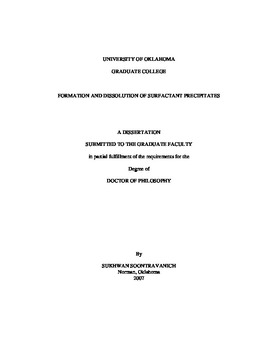| dc.contributor.advisor | Scamehorn, John F., | en_US |
| dc.contributor.author | Soontravanich, Sukhwan. | en_US |
| dc.date.accessioned | 2013-08-16T12:20:54Z | |
| dc.date.available | 2013-08-16T12:20:54Z | |
| dc.date.issued | 2007 | en_US |
| dc.identifier.uri | https://hdl.handle.net/11244/1262 | |
| dc.description.abstract | Precipitation of surfactants is one of the most important considerations in surfactant applications. Understanding the formation and dissolution of surfactant precipitates provides more effective utilization of surfactants. In this study, firstly, the kinetics of precipitation of mixed anionic surfactants with calcium ion was studied and the relationship between the supersaturation ratios of precipitating surfactants and the rate of surfactant precipitation was established. The precipitation in mixed anionic surfactants is delayed substantially when the supersaturation ratios of precipitating surfactants are approximately the same, indicating the growth of each precipitating surfactant is interrupted by use of growing crystals as nucleation sites for the dissimilar surfactant to form crystals. Secondly, precipitation phase boundaries of an anionic surfactant and a pH sensitive amphoteric surfactant were measured and modeled at different pH levels. A hydrogen ion titration to obtain the pKa of the amphoteric surfactant, regular solution theory to describe mixed micelle formation, and the solubility product of the precipitate were combined to predict the precipitation phase boundary. Lastly, the thermodynamics and kinetics of the dissolution of precipitate of calcium salt of a long chain fatty acid or soap scum using water-soluble surfactants and ligand were studied. Simultaneous removal of calcium from the soap scum molecule by ligand complexation and formation of mixed micelles of the alkyl carboxylate anion molecules and co-surfactants are responsible for high solubility and rapid dissolution of soap scum. The solution pH plays an important role in the dissolution in this system as pH affects the dissociation of calcium from soap scum molecule and the release of calcium by affecting the effectiveness of the chelating agent used, as well as affecting the formation of mixed micelles by altering the charge on the surfactant head groups of a pH-sensitive amphoteric surfactant when used as an added surfactant. | en_US |
| dc.format.extent | xvi, 180 leaves : | en_US |
| dc.subject | Surface active agents. | en_US |
| dc.subject | Surface chemistry. | en_US |
| dc.subject | Precipitation (Chemistry) | en_US |
| dc.subject | Engineering, Chemical. | en_US |
| dc.title | Formation and dissolution of surfactant precipitates. | en_US |
| dc.type | Thesis | en_US |
| dc.thesis.degree | Ph.D. | en_US |
| dc.thesis.degreeDiscipline | School of Chemical, Biological and Materials Engineering | en_US |
| dc.note | Source: Dissertation Abstracts International, Volume: 68-10, Section: B, page: 6821. | en_US |
| dc.note | Adviser: John F. Scamehorn. | en_US |
| ou.identifier | (UMI)AAI3283863 | en_US |
| ou.group | College of Engineering::School of Chemical, Biological and Materials Engineering | |
